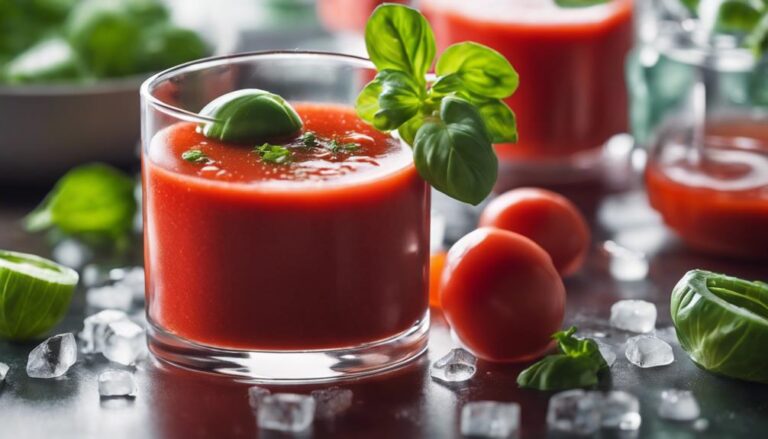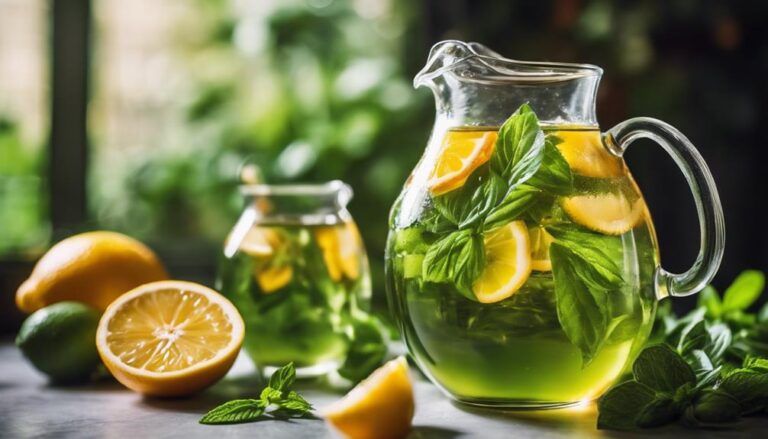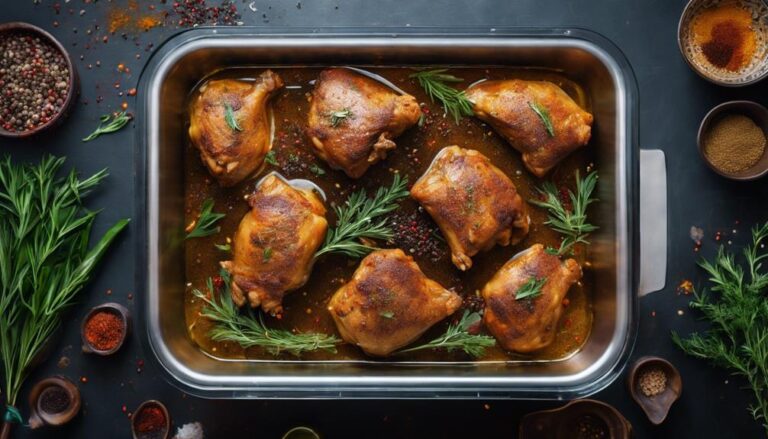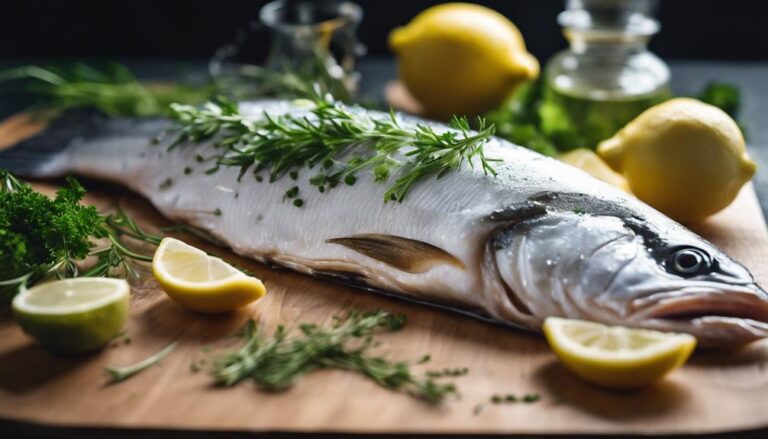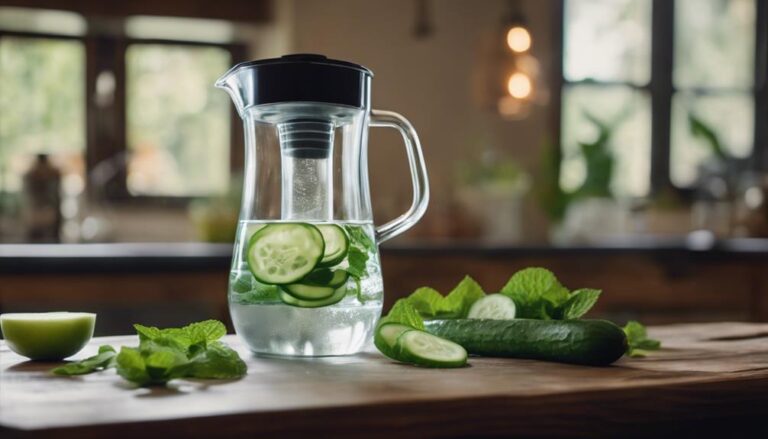Sous Vide Pork Tenderloin With Fig and Balsamic Glaze
Achieve culinary excellence by preparing Sous Vide Pork Tenderloin with Fig and Balsamic Glaze. Enhance tenderness and flavor by marinating in a blend of sweet figs and rich balsamic vinegar. Sear the tenderloin to perfection, creating a delightful crust that guarantees locked-in juices and intensifies flavors. The meticulous process of sous vide cooking guarantees precise results and a succulent texture. Elevate your dining experience with this exquisite dish that promises a symphony of tastes in every bite. Master the art of blending sweet and savory elements for a truly unforgettable meal that will tantalize your taste buds.
What You Will Learn Here
- Sous vide cooking ensures precise and consistent results.
- Fig and balsamic glaze enhance pork tenderloin taste.
- Marinating with flavorful mixture adds layers of flavor.
- Oven-roasting at 400°F yields tender and juicy pork.
- High-quality balsamic vinegar creates a sweet and tangy profile.
Origin of Balsamic Vinegar
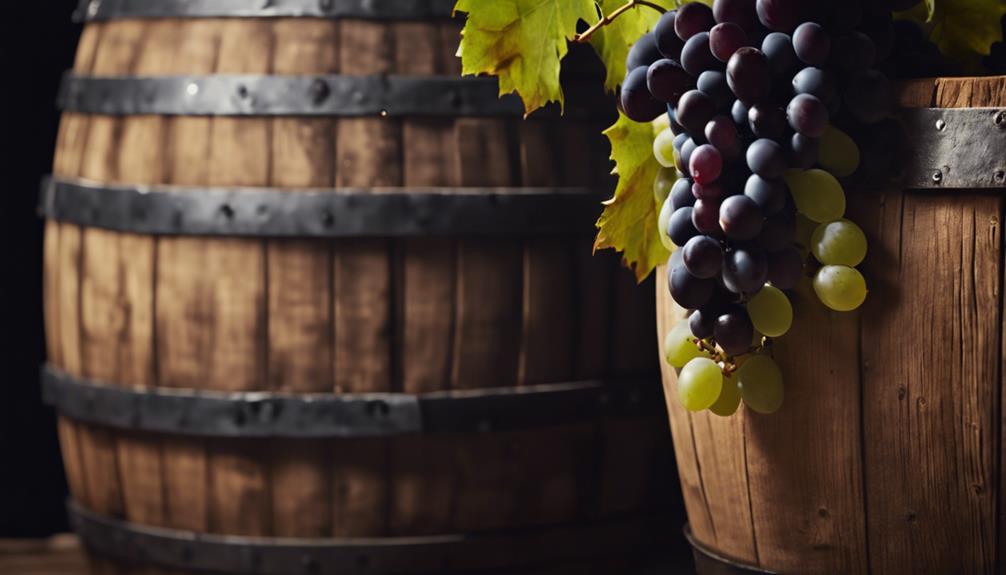
Balsamic vinegar, derived from Italy's Modena and Reggio Emilia regions, boasts a storied history. Crafted meticulously from grape must and aged for at least 12 years in wooden barrels, it develops its signature sweet and complex taste.
The various aging processes yield a spectrum of flavors, making balsamic vinegar a prized ingredient in culinary creations.
Balsamic Vinegar History
Originating from the regions of Modena and Reggio Emilia in Italy, balsamic vinegar is crafted from Trebbiano grape must and undergoes a meticulous aging process in wooden barrels for a minimum of 12 years, resulting in a distinctive and multifaceted flavor profile. The history of balsamic vinegar is rich, with its origins dating back to ancient times. Initially prized for its medicinal properties, balsamic vinegar evolved into a luxury item enjoyed by royalty and nobility. The term 'balsamic' itself, derived from the Italian word 'balsamico,' reflects its healing connotations. This revered vinegar has a long-standing tradition of being a symbol of status and sophistication. Explore the intriguing journey of balsamic vinegar through the centuries in the table below:
| Historical Significance | Culinary Evolution |
|---|---|
| Medicinal tonic | Gourmet ingredient |
| Royalty's luxury item | Flavor enhancer |
| Symbol of prestige | Versatile condiment |
Balsamic Production Process
The evolution of balsamic vinegar from a medicinal tonic to a gourmet ingredient signifies a transformation in both its historical significance and culinary application, setting the stage for an exploration of the intricate balsamic production process.
Balsamic vinegar, originating from Italy, particularly the Modena and Reggio Emilia regions, is crafted using traditional methods. Made from cooked grape must, this vinegar undergoes a meticulous aging process in wooden barrels. The traditional balsamic vinegar can mature for anywhere between 12 to 25 years, resulting in its renowned rich and complex flavor profile, characterized by sweet and tangy notes.
The production of balsamic vinegar involves a careful balance of fermentation and aging, ensuring the development of its distinctive taste that has become a staple in gourmet cuisine.
Balsamic Flavor Varieties
Crafted in the picturesque regions of Modena and Reggio Emilia in Italy, balsamic vinegar's diverse flavor varieties showcase the intricate artistry of its production process. Balsamic vinegar originates from Italy, specifically Modena and Reggio Emilia regions. Traditional balsamic vinegar is aged for a minimum of 12 years, while some varieties age up to 25 years. The flavor profile of balsamic vinegar ranges from sweet and syrupy to tangy and acidic, depending on the aging process. This versatility is what makes it a perfect complement to dishes like Sous Vide Pork Tenderloin with Fig and Balsamic Glaze. The complex and rich flavors of balsamic vinegar add depth to dishes like roast pork, elevating them to a gourmet level.
| Balsamic Vinegar | Fig and Balsamic | Pork Tenderloin |
|---|---|---|
| Sweet and syrupy | Tangy and acidic | Versatile |
Balsamic Vinegar Aged in Barrels
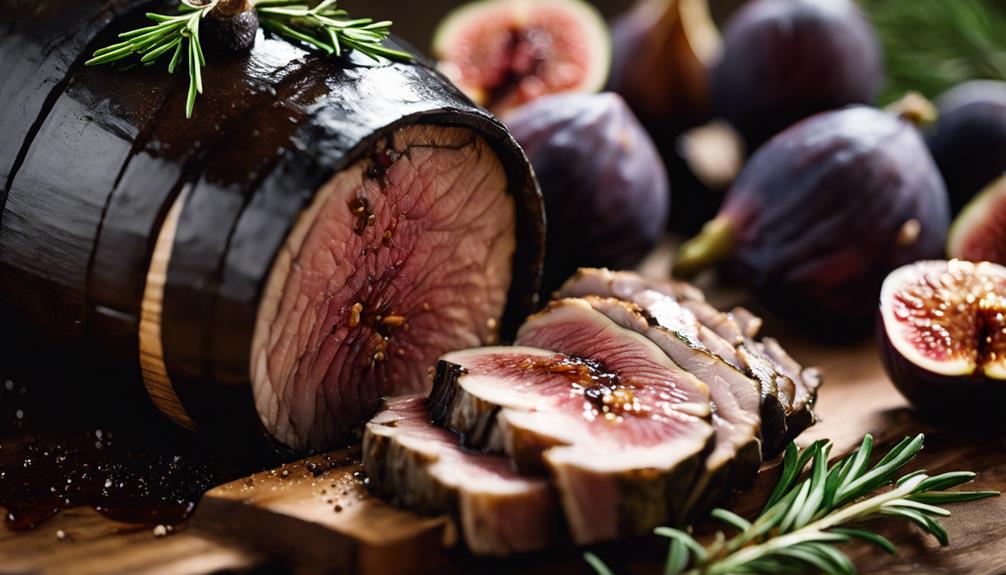
Aged in wooden barrels, balsamic vinegar undergoes a vital process that enhances its flavors and creates a rich, intense taste profile. The intricate dance between the vinegar and the wood imbues the balsamic with a depth that elevates dishes to new levels of deliciousness. Here's why barrel aging is essential for balsamic vinegar:
- Fermentation Magic: The time spent in the barrels allows for a slow, natural fermentation process that imparts a nuanced flavor profile to the vinegar, enhancing even the simplest of dishes.
- Wooden Symphony: Each type of wood used in the barrels, be it oak, cherry, or chestnut, adds its own unique essence to the balsamic, creating a symphony of flavors that dance on your taste buds.
- Syrupy Elegance: Through the patient aging in wooden barrels, balsamic vinegar acquires a luxurious, syrupy consistency that can add a touch of elegance to everything from salads to meats.
Fig-infused Pork Tenderloin Variations
When it comes to fig-infused pork tenderloin variations, consider how searing the meat can elevate its flavors and create a delightful crust.
The importance of a well-balanced balsamic fig sauce can't be overstated, as it ties together the sweet and savory elements of the dish.
For a different approach, you might explore the option of preparing an oven-roasted balsamic pork tenderloin for a richer and slightly caramelized result.
Searing Is a Game-Changer
Enhancing the fig-infused pork tenderloin with a perfectly executed sear can truly elevate the dish to new heights of flavor and texture. Searing the pork tenderloin before sous vide cooking initiates the Maillard reaction, enhancing the flavor with rich, caramelized notes. This process not only creates a delightful crust but also helps seal in the natural juices, guaranteeing a tender and juicy outcome. The contrast between the crispy exterior and succulent interior adds a delightful textural element to each bite. Searing isn't merely a cooking step but a transformative process that turns a good dish into an exceptional culinary experience.
- Searing Enhances Flavor: The Maillard reaction adds depth and complexity.
- Improved Texture: Crispy exterior complements the tender interior.
- Juicy Outcome: Sealing in juices guarantees a moist and succulent pork tenderloin.
Balsamic Fig Sauce Importance
With the fig-infused pork tenderloin now perfectly seared, the next essential step lies in preparing the balsamic fig sauce to enhance the dish's overall taste profile.
The balsamic fig sauce plays a pivotal role in elevating the flavor of the Balsamic Pork Tenderloin through its rich and tangy notes. The sweetness of the fig jam combined with the savory undertones of balsamic creates a delightful balance that tantalizes the taste buds.
Seasoned with just the right amount of salt and pepper, the sauce harmonizes perfectly with the sous vide-cooked pork, offering a gourmet experience that's both elegant and sophisticated.
Oven-Roasted Balsamic Pork Tenderloin
To achieve a succulent and flavorful dish, ponder the various fig-infused variations for oven-roasted balsamic pork tenderloin. When preparing this dish, the fig-infused balsamic glaze plays an essential role in enhancing the overall taste profile of the pork. The oven-roasting method guarantees that the pork tenderloin cooks evenly while retaining its moisture, resulting in a juicy and tender texture.
Here are some emotional cues to ponder when exploring fig-infused pork tenderloin variations:
- Indulge in the rich and decadent flavors of fig-infused balsamic glaze.
- Experience the tantalizing aroma of oven-roasted pork tenderloin with a hint of fig sweetness.
- Delight your taste buds with the perfect balance of tangy balsamic and sweet fig notes.
Searing Enhances Pork Flavor
When you sear pork tenderloin, you're not just creating a beautiful crust; you're also locking in those juicy flavors.
The Maillard reaction that occurs during searing is what brings out the depth and complexity in the pork's taste.
This process not only contributes to the overall flavor but also guarantees a moist and tender result that will have you coming back for seconds.
Searing Locks in Juices
Searing pork tenderloin creates a flavorful crust that locks in juices and enhances the overall taste of the meat. When you sear the pork before sous vide cooking, you're essentially sealing in those natural juices that are important for succulence.
The high heat from searing triggers the Maillard reaction, which not only browns the exterior but also intensifies the flavor profile. As the surface caramelizes, it adds a rich depth that complements the tender texture inside.
This quick sear is essential for developing a beautifully browned exterior that contrasts with the juicy, tender interior of the pork. By searing, you're setting the stage for a mouthwatering experience that will enhance the overall taste of your pork tenderloin.
Flavorful Crust Develops
Developing a flavorful crust on the outside of your pork tenderloin is essential for enhancing its overall taste and texture. When searing the pork tenderloin, the Maillard reaction occurs, creating a complex flavor profile that complements the sous vide-cooked meat. This reaction not only adds depth to the taste but also results in an appealing golden-brown color on the exterior.
Searing helps seal in the natural juices and moisture of the pork, ensuring a succulent and juicy bite with each slice. The contrast between the well-seared crust and the tender interior from sous vide cooking provides a satisfying textural experience.
Enhances Overall Taste
To elevate the overall taste of your pork tenderloin, the process of searing plays an essential role in enhancing the flavors by creating a caramelized crust. When you sear the pork before sous vide cooking, the Maillard reaction occurs, adding depth and complexity to the flavor profile. This reaction not only intensifies the taste but also locks in juices, resulting in a juicy and succulent texture when combined with sous vide cooking. Additionally, the quick sear helps develop a rich color on the pork's surface, enhancing visual appeal. The contrast in texture between the crispy exterior created by searing and the tender interior achieved through sous vide cooking creates a delightful eating experience.
| Searing | Flavor |
|---|---|
| Juicy | Texture |
Enjoy the perfect combination of flavors and textures by incorporating searing into your sous vide pork tenderloin preparation.
Final Thoughts
In conclusion, the harmonious blend of flavors achieved through sous vide cooking and the fig and balsamic glaze elevates the pork tenderloin dish to a culinary masterpiece. Sous vide cooking guarantees precise and consistent results, ensuring the pork tenderloin is perfectly cooked every time.
The fig and balsamic glaze contribute a delightful sweet and tangy profile that enhances the overall taste of the dish. Marinating the pork tenderloin with a mixture of apricot jam, fig jam, grain mustard, and olive oil adds layers of delicious flavors that infuse into the meat.
When oven-roasted at 400°F after marinating, the pork tenderloin becomes tender and juicy, creating a perfect pairing with the fig and balsamic glaze. Remember, using high-quality balsamic vinegar or a thick balsamic glaze is essential for developing a rich and flavorful sauce that complements the pork beautifully.
Experience the exquisite flavors and textures of this dish by trying out the sous vide pork tenderloin with fig and balsamic glaze recipe today.
Frequently Asked Questions
Do You Sear Pork Tenderloin Before or After Sous Vide?
For the best flavor retention and texture, sear your pork tenderloin before sous vide. This method enhances taste and reduces overall cooking time. Sous vide benefits from pre-searing by locking in juices and setting the stage for a delicious dish.
What Is the Best Temperature to Sous Vide Pork?
For the best sous vide pork, set the temperature between 140°F to 145°F. This range guarantees juicy tenderness, safe cooking, and flavor infusion. Sous vide techniques assure precise cooking without drying out the meat, offering consistent results.
What Is Balsamic Fig Glaze Made Of?
Balsamic fig glaze combines balsamic reduction and fig syrup for a sweet, tangy flavor. The cooking techniques enhance the glaze's consistency, perfect for drizzling over dishes. Its balance of sweet and tangy notes offers a delightful addition to various meals.
Do You Sear Pork Tenderloin Before or After Baking?
You should sear pork tenderloin before baking for a flavorful crust, sealing in juices. Searing enhances color, taste, texture, and depth of flavor. Using appropriate searing techniques before baking guarantees a juicy and tender outcome with excellent temperature control.
Conclusion
Indulge in the succulent flavors of sous vide pork tenderloin with fig and balsamic glaze.
The tender pork, infused with the sweetness of fig and the tang of balsamic vinegar, creates a harmonious balance of flavors.
Searing the pork enhances its natural juices and adds a crispy texture.
This dish is a perfect blend of savory and sweet, making it a delightful choice for any meal.
Enjoy the rich and luxurious taste of this exquisite dish!






